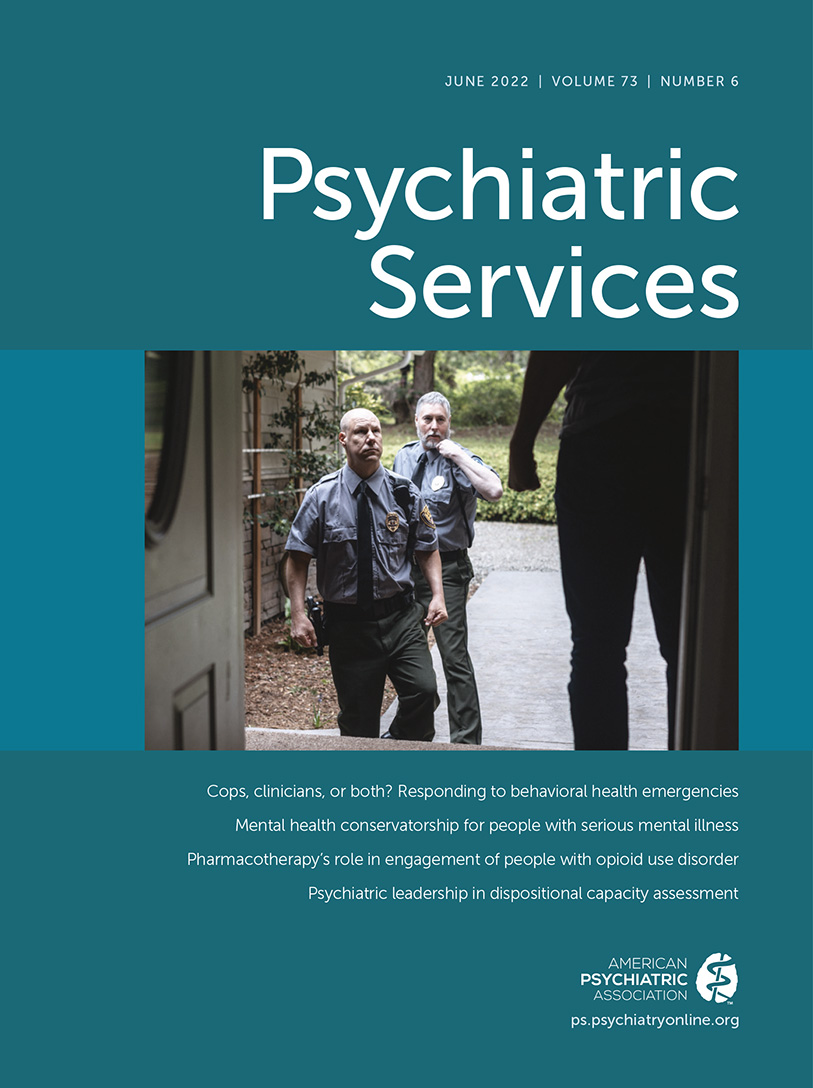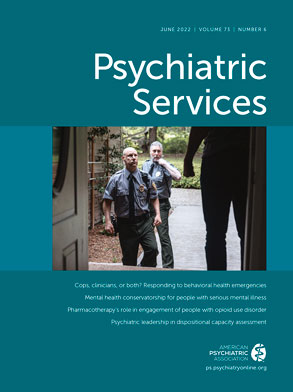To address the high prevalence of mental and substance use disorders in jails (
1–
3), medical societies have called for expanded treatment for justice-involved individuals in carceral and community settings (
4). Such treatment includes conducting evidence-based screening, delivering a range of medication and therapy treatment options, addressing the unique needs of pregnant and parenting women, and providing linkage to community treatment after incarceration. Several large initiatives are underway to improve care for justice-involved individuals; these initiatives include individuals in correctional facilities and those in the community who are under correctional supervision. One example is Stepping Up, a national effort to enlist counties to commit to reducing the number of people with mental illness in jails, which is sponsored by the American Psychiatric Foundation, National Association of Counties, and Council of State Governments (
5). Other examples include the HEALing Communities Study, a component of the National Institutes of Health HEAL (Helping to End Addiction Long-term) Initiative and the National Institute on Drug Abuse Justice Community Opioid Innovation Network (JCOIN). In addition, several federal funding programs through the Substance Abuse and Mental Health Services Administration (SAMHSA) and the Bureau of Justice Assistance (BJA) seek to expand treatment capacity for mental and substance use disorders in probation departments, jails, and specialized treatment-based courts, such as mental health and drug courts.
Unfortunately, most counties do not participate in these efforts, leaving justice-involved populations at continued risk of poor mental health, substance use, and judicial outcomes (
6). At the same time, the cost to counties of untreated mental and substance use disorders is high. For example, clients with such disorders who are in jail tend to have longer stays, compared with other clients (
7), and upon release, they are more likely to violate probation terms and to recidivate (
2). This study examined how county participation in initiatives to improve treatment for mental and substance use disorders among justice-involved clients is associated with counties’ economic, criminal justice, and health care delivery characteristics in order to identify potential barriers to county adoption and to inform policy solutions.
Methods
We studied 2,922 out of 3,142 counties and county equivalents in the United States. We excluded counties in Puerto Rico, counties in six states (Alaska, Connecticut, Delaware, Hawaii, Rhode Island, and Vermont) with consolidated jail-prison systems, five counties with no reported jail population, and 22 counties with total resident populations under 1,000. We identified counties participating in several federal initiatives to expand treatment capacity for mental and substance use disorders for justice-involved individuals. These included 169 counties in the HEALing Communities Study or in JCOIN, 466 counties that joined Stepping Up through 2020, and 421 counties that were awarded grants by SAMHSA or BJA to support substance use and mental health services in court or jail settings between 2018 and 2020. (Details of the data are included in an
online supplement to this column.)
We examined counties’ law enforcement, crime, sociodemographic, and health care delivery characteristics. County criminal justice measures were derived from the federal Uniform Crime Reporting Program and the Vera Institute of Justice, sociodemographic characteristics were from the American Community Survey, and provider supply data were from SAMHSA directories of providers with a buprenorphine waiver and of specialty outpatient opioid treatment programs. We created an indicator for whether the county was in one of 39 states, including the District of Columbia, with an adult Medicaid expansion program (
8). From the Health Resources and Services Administration, we obtained information about whether a county was a health professional shortage area for mental health, whether the county had a federally qualified health center or rural health center, and the number of psychiatrists and psychologists per 100,000 population. Because counties may draw on clinical resources beyond their immediate boundaries (
9), we also created measures of clinic and provider supply that included the immediately adjacent counties.
For our county sample, we conducted statistical tests of differences in characteristics between those that participated in at least one of the federal substance use and mental health initiatives and those that did not. We estimated linear models that controlled for county rural status and reported the regression-adjusted means by characteristic for participating and nonparticipating counties. We clustered standard errors at the state level. Analyses began in February 2021 and were performed with Stata, version 16.1.
Results
Overall, 818 (28%) of the 2,922 counties participated in at least one of the behavioral health–criminal justice initiatives, and 215 (7%) participated in two or more initiatives. Rural counties accounted for only 17% (N=139) of participating counties, although they represented 40% (N=1,169) of our overall sample. When the analysis controlled for county rural status, participating counties had fewer jail days and fewer law enforcement personnel on a population-adjusted basis. Violent crime rates were higher in the participating counties, but differences were not statistically significant (
Table 1). We found no statistically significant differences in sociodemographic characteristics between participating and nonparticipating counties, including in the proportion of White non-Hispanic persons, unemployment rate, poverty rate, or the level of income inequality. However, participating counties had lower rates of uninsured individuals and were more likely to be in states that had expanded Medicaid coverage.
We found statistically significant differences in participation status across all measures of county provider supply. Participating counties were more likely than nonparticipating counties to have any buprenorphine-waivered providers, opioid use disorder treatment facilities, and federally qualified health centers and had more psychiatrists and psychologists per 100,000 population. The differences were large: the rate per 100,000 in the participating counties was two-thirds higher for psychologists and nearly twice as high for psychiatrists. Participating counties were more than twice as likely to have an opioid use disorder treatment facility as nonparticipating counties. Large supply differences persisted when the supply of neighboring counties was taken into account.
A limitation of our study was that we were not able to measure substance use and mental health treatment services delivered within jails. We also did not include initiatives sponsored by states, including those financed with federal funding, which may have supported county substance use and mental health services for jail or community corrections’ clients. We lacked specific data on how state grant funds were allocated, but we speculate that these allocations may be highly correlated with funding sought by counties.
Conclusions
These results suggest that counties with substantially better community mental health and substance use care delivery infrastructure are more likely to participate in national initiatives aimed at improving behavioral health care for justice-involved clients. When the analysis controlled for rural status, violent crime and most of the county socioeconomic characteristics examined, such as income and income inequality, were not associated with participation. In contrast, higher rates of health insurance coverage and more community providers and services were associated with county participation in federal capacity-building programs.
Nonparticipating counties invested more heavily in law enforcement personnel and jail capacity, compared with participating counties. On one hand, this investment may reflect differences in local priorities. On the other hand, the differences in provider capacity also suggest that counties that need help the most may not meet basic delivery system prerequisites to join the national programs or may not have sufficient local expertise to apply for them. The implication is that geographic disparities in care and outcomes for justice-involved clients are likely to persist and even to grow. Greater investment in provider expansion, through infrastructure and workforce development, technical assistance, as well as expansion of telehealth, peer professionals, and insurance coverage through Medicaid expansion, could improve capacity and enable more counties to participate in such innovative programs.

